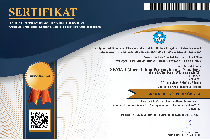Pelatihan Cyber Security Sebagai Pengetahuan Dasar Keamanan Untuk Peningkatan Security Awarness
Abstract
Full Text:
PDFReferences
Akhtar, Z.B. and Rawol, A.T. (2024) ‘Uncovering Cybersecurity Vulnerabilities: A Kali Linux Investigative Exploration Perspective’, International Journal of Advanced Network, Monitoring and Controls, 9(2), pp. 11–22. Available at: https://doi.org/10.2478/ijanmc-2024-0012.
Braka, F. et al. (2023) ‘The role of polio emergency operations centers: perspectives for future disease control initiatives in Nigeria’, The Pan African Medical Journal, 45. Available at: https://doi.org/10.11604/pamj.supp.2023.45.2.41308.
Chang, A.S., Lee, C.H. and Leu, W.H. (2011) ‘Coordination Needs and Performance for Manufacturing Process Improvement Projects’, Advanced Materials Research, 311–313, pp. 2239–2244. Available at: https://doi.org/10.4028/www.scientific.net/AMR.311-313.2239.
Da Silva, A.G., Sá Guerreiro, C. and Malta, D.C. (2023) ‘Meta‐evaluation of studies on community physical activity programs in Brazil’, The International Journal of Health Planning and Management, 38(1), pp. 252–264. Available at: https://doi.org/10.1002/hpm.3585.
Dahl, M. et al. (2021) ‘Involving people with type 2 diabetes in facilitating participation in a cardiovascular screening programme’, Health Expectations, 24(3), pp. 880–891. Available at: https://doi.org/10.1111/hex.13228.
Dietrich, P., Kujala, J. and Artto, K. (2013) ‘Inter-Team Coordination Patterns and Outcomes in Multi-Team Projects’, Project Management Journal, 44(6), pp. 6–19. Available at: https://doi.org/10.1002/pmj.21377.
Dikito, A.R., Kaiser, M.S. and Vincent, J.P. (2024) ‘Factors Influencing Cybersecurity: A Focus Group Approach’, International Journal of Academic Research in Progressive Education and Development, 13(4), p. Pages 754-767. Available at: https://doi.org/10.6007/IJARPED/v13-i4/23539.
Hassan, S.Z. ul, Muzaffar, Z. and Ahmad, S.Z. (2021) ‘Operating Systems for Ethical Hackers - A Platform Comparison of Kali Linux and Parrot OS’, International Journal of Advanced Trends in Computer Science and Engineering, 10(3), pp. 2226–2233. Available at: https://doi.org/10.30534/ijatcse/2021/1041032021.
Hemingway, B.L., Douville, S. and Fierro, L.A. (2022) ‘Aligning Public Health Training and Practice in Evaluation: Implications and Recommendations for Educators’, Pedagogy in Health Promotion, 8(4), pp. 324–331. Available at: https://doi.org/10.1177/23733799211033621.
Irwandy, I. et al. (2024) ‘Cybersecurity Culture Among Healthcare Workers in Indonesia: Knowledge Gaps, Demographic Influences, and Strategic Policy Solutions’. Available at: https://doi.org/10.21203/rs.3.rs-5421169/v1.
Khaw, T.Y., Amran, A. and Teoh, A.P. (2024) ‘Building a thematic framework of cybersecurity: a systematic literature review approach’, Journal of Systems and Information Technology, 26(2), pp. 234–256. Available at: https://doi.org/10.1108/JSIT-07-2023-0132.
Lu, H.-J. and Yu, Y. (2021) ‘Research on WiFi Penetration Testing with Kali Linux’, Complexity. Edited by M.I. Uddin, 2021(1), p. 5570001. Available at: https://doi.org/10.1155/2021/5570001.
Maccalla, N.M.G. et al. (2022) ‘Gauging treatment impact: The development of exposure variables in a large‐scale evaluation study’, New Directions for Evaluation, 2022(174), pp. 57–68. Available at: https://doi.org/10.1002/ev.20509.
Milosek, J., Eady, K. and Moreau, K.A. (2023) ‘Program Evaluation Activities in Competence by Design: A Survey of Specialty/Subspecialty Program Directors’. Available at: https://doi.org/10.21203/rs.3.rs-3369555/v1.
Mojidra, M. et al. (no date) ‘The Impact of Stakeholder Communication and Coordination on Project Outcome – IJSREM’. Available at: https://ijsrem.com/download/the-impact-of-stakeholder-communication-and-coordination-on-project-outcome/ (Accessed: 21 February 2025).
Nair, P. (2023) ‘Enhancing Cybersecurity Awareness Training through the NIST Framework’, IJARCCE, 12(12). Available at: https://doi.org/10.17148/IJARCCE.2023.121203.
Neri, M., Niccolini, F. and Martino, L. (2024) ‘Organizational cybersecurity readiness in the ICT sector: a quanti-qualitative assessment’, Information & Computer Security, 32(1), pp. 38–52. Available at: https://doi.org/10.1108/ICS-05-2023-0084.
Panday, M.S., Wang, P.N. and Spasova, I.H. (2023) ‘Participatory Project Planning and Performance of Donor Funded Projects in Khulna, Bangladesh’, Journal of Entrepreneurship & Project Management, 7(5), pp. 1–11. Available at: https://doi.org/10.53819/81018102t5193.
Rattanapong, P. and Ayuthaya, S.D.N. (2025) ‘Influential factors of cybersecurity investment: A quantitative SEM analysis’, Management Science Letters, 15(1), pp. 31–44. Available at: https://doi.org/10.5267/j.msl.2024.3.005.
Ritzkal et al. (2024) ‘Enhancing Cybersecurity Through Live Forensic Investigation of Remote Access Trojan Attacks using FTK Imager Software’, International Journal of Safety and Security Engineering, 14(1), pp. 217–223. Available at: https://doi.org/10.18280/ijsse.140121.
Senore, C. et al. (2015) ‘Optimising colorectal cancer screening acceptance: a review’, Gut, 64(7), pp. 1158–1177. Available at: https://doi.org/10.1136/gutjnl-2014-308081.
Sun, N. et al. (2022) ‘How Do Organizations Seek Cyber Assurance? Investigations on the Adoption of the Common Criteria and Beyond’. Available at: https://doi.org/10.48550/ARXIV.2203.01526.
Tinmouth, J. et al. (2014) ‘Using physician-linked mailed invitations in an organised colorectal cancer screening programme: effectiveness and factors associated with response’, BMJ Open, 4(3), p. e004494. Available at: https://doi.org/10.1136/bmjopen-2013-004494.
Twenge, J.M., Spitzberg, B.H. and Campbell, W.K. (2019) ‘Less in-person social interaction with peers among U.S. adolescents in the 21st century and links to loneliness’, Journal of Social and Personal Relationships, 36(6), pp. 1892–1913. Available at: https://doi.org/10.1177/0265407519836170.
Refbacks
- There are currently no refbacks.























